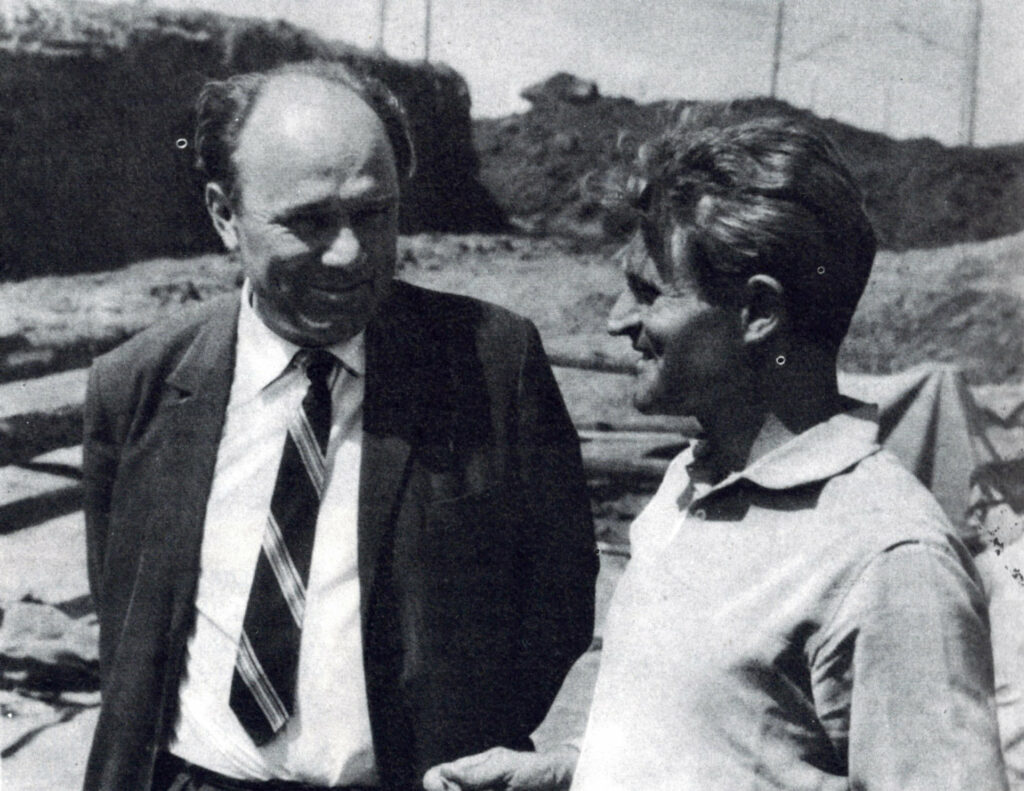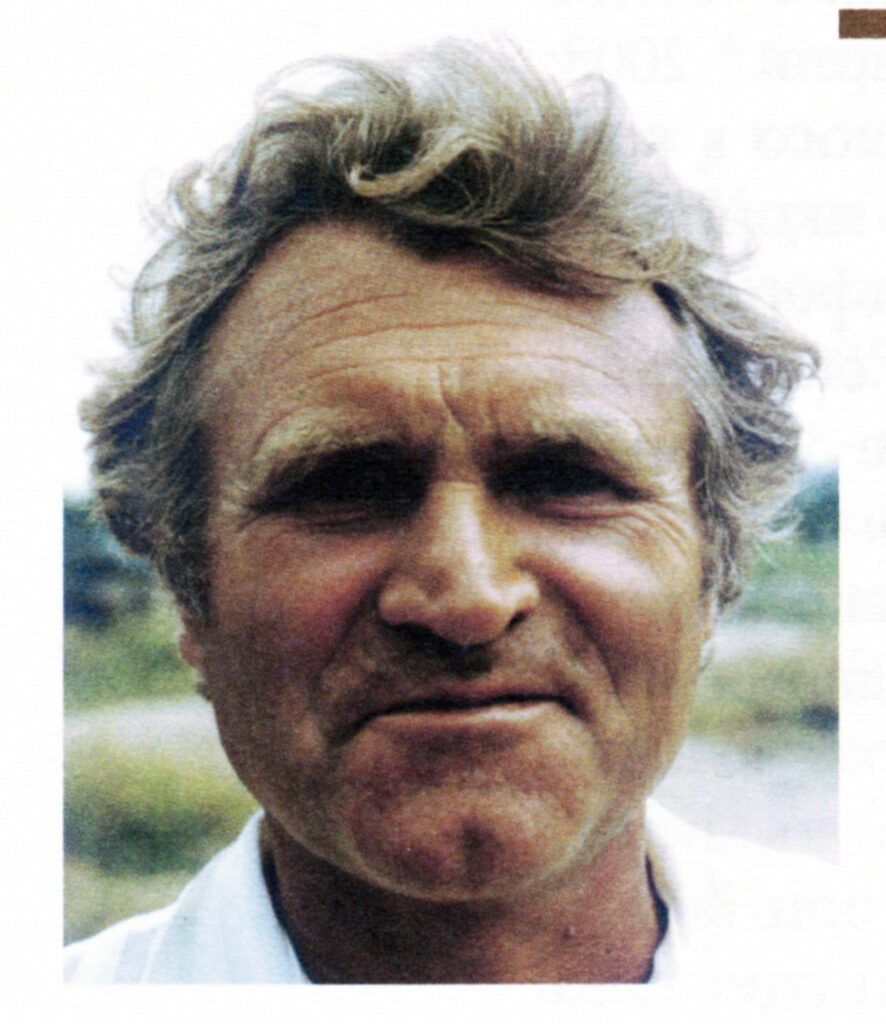Half a century since the discovery of the golden Scythian pectoral is a good opportunity to remember both the researcher who found it and the modern problems of archeology. In particular, those researchers who every spring, without loud announcements in the media, go in search of fragments of knowledge that will help to recreate the picture of history as a whole.
GO FOR EXCAVATIONS – FROM STEAMSHOP
… In the spring of 1971, Borys Mozolevsky began excavating the Tovsta Mohyla mound near the town of Ordzhonikidze (now Pokrov). He woke up at 5.30 A.M. every day and, without waiting for dawn, went to the excavation site in the cold wind. Clouds piled up over the mound and over the young explorer. The “people in civilian clothes” (i.e., the KGB) became very interested in the scholar who wrote poems about Ukraine.
What in the actions of Borys Mozolevsky did not fit into the standard (read – safe for himself) behavioral constraints? He studied at the Naval Academy in Yeisk, wrote poetry in Russian, after early mobilization came to Kyiv. Worked as a fireman at the enterprise and studied by correspondence in History and Philosophy Faculty of Taras Shevchenko State University of Kyiv. He changed over to Ukrainian and wrote poems in it. In 1964 he graduated from the University, participated in archaeological expeditions, worked in the Naukova Dumka (Scientific Thought) Publishing House. Khrushchev’s thaw gave a deceptive feeling of freedom, and once a young scientist organized a literary soiree dedicated to the poets of the sixties. He was immediately discharged from the Naukova Dumka Publishing House and taken under KGB surveillance.
Borys Mozolevsky got a job at a steamshop, where he became friends with another fireman- poet, Vasyl Stus. However, Borys Mozolevsky did not leave archeology. In 1968 he took part in field research of the Gaimanova Mohyla group of mounds in the Zaporizhia region, and in 1970 he led an archeological expedition in the Dnipropetrovsk region.
In the winter of 1971, Borys Mozolevsky was already awaiting arrest. In one of the poems, he writes:
Will the strength not to kneel,
Do not fall, do not break in the winds?
Will I meet a new spring in Kyiv,
Or maybe in one of Mordovian camps? ..
An incident saved the young scientist from arrest. A giant Mining and Processing Plant planned to expand its quarry near the town of Ordzhonikidze, and the Tovsta Mohyla mound stood in the way of socialist achievements. The Plant’s Director, Hryhoriy Sereda, loved and respected history and could not allow the archeological site to be demolished unnoticed. He personally arrived at the Institute of Archeology with a request to immediately send an expedition to the mound. Hryhoriy Sereda promised to give equipment and support, and the Institute’s management agreed. At the request of Sereda, young Mozolevsky was sent to the excavations.

GOLD IN A SWEATSHIRT
The Director of the Mining and Processing Plant kept his word and gave the archaeologists scrapers (earthmoving machines). But no matter how tirelessly the technology worked, the scientists had to watch and direct the process. Borys Mozolevsky describes the working days of the expedition in his diary: “Every day, without rest and weekends, I stared at the ground till eye pain, trying to read every earth lump, cleaned and measured, then abandoned everything and ran again from scraper to scraper, grabbed a shovel, drew and described. We returned to the hotel around midnight, being numb with cold and deaf because of roar of vehicles, and without washing, fell like dead on bed, and the next day continued that mad battle … “.
Archaeologists quickly realized that in ancient times the burial was looted, but the looters did not reach all the premises. Researchers found the decoration of a cart and harness, horses, grooms… In the side tomb they found an unspoiled burial of a Scythian woman. The woman was lying in a dress embroidered with gold, and next to her, in a sarcophagus, was her child.
However, the real triumph was ahead. June 21, 1971 was the most important date for Borys Mozolevsky. “At the end of the dromos (…) we found a large round gold object, which turned out to be a pectoral. It happened at 2.30 P.M.… Everyone immediately whooped with joy and started kissing…,” the researcher wrote in his diary.
In the corridor-dromos of the central tomb they found a sword in golden scabbards, a golden whip binding and a golden pectoral, weighing more than a kilogram.
The archaeologist decided to bring the find to the capital personally. Then there was a meeting with Oles Honchar and the First Secretary of the Central Committee of the Communist Party of Ukraine Petro Shelest. The Director of the Institute of Archeology Fedir Shevchenko and the President of the Academy of Sciences of the UkrSSR Borys Paton were already waiting for the researcher in Shelest’s office. Mozolevsky received a job (he was enrolled in the Institute retrospectively) and housing. Later he will write a monograph on the excavations in Tovsta Mohyla, and the pectoral will become one of the symbols of Ukraine.
WHO OWNED THE DECORATION?
Has the gold find been fully examined in half a century? Who exactly was its owner? And what tasks do archaeologists set for themselves today? We asked Yuriy Boltryk, Head of the Field Committee Department at the Institute of Archeology of the National Academy of Sciences, about this.
– The task of archeology is to find evidence of life and work of individuals, communities and states, – said the scientist. – Of course, such finds as pectoral are extremely rare. But everything is important for science, even inconspicuous things. For example, shells from Paleolithic times can tell a lot about the conditions in which primitive people lived, the climate of those times, and so on.
Yuriy Boltryk emphasizes that the pectoral, considered royal by many researchers, did not actually belong to the head of Scythia (which does not diminish its value), but to a person who was two social levels lower.
– As a Scythologist, I am annoyed that the Tovsta Mohyla mound is called royal, – the researcher continued. – This mound is 7-8 times smaller than the Chortomlyk mound. The social level of a buried person is evidenced, first of all, by the size of the mound and presence of gold in the horse graves (because the burial complexes are usually completely looted). Mounds of kings of the 4th century B.C. have more than 82 thousand cubic meters. Mounds of relatives or associates of the ruler – 36-40 thousand cubic meters (this is, for example, Oleksandropil mound in Dnipropetrovsk region). Tovsta Mohyla is not a royal mound. The man buried there had a very high social status, but was not the head of the Scythian state.

For half a century the pectoral has been thoroughly studied and interpreted. Scientists have concluded that it was made by ancient masters, whose workshop was located in Athens or in Pantikapaion (now Kerch). In the same workshop (with the same creative “handwriting”) an amphora was made, which was found in the royal Chortomlyk mound in the 19th century on the territory of modern Dnipropetrovsk region (it is kept in the Hermitage).
Both on the amphora and on the pectoral, there are three levels (friezes), which depict three mythological worlds – the upper, middle and lower one. The semantic center of the decoration composition consists of two men in the upper frieze. According to Yuriy Boltryk, they repair a shell made of iron scales. Perhaps these are two kings who symbolically validate a treaty.
The middle frieze depicts plants and birds. “This is a symbolic image of the tree of life, a model of the Universe, which is common in many mythologies and religions,” – said Yuriy Boltryk.
At the lower level you can see the traditional for the Scythians, as representatives of the ancient Iranian world, scene of shredding, in which mythical predators attack a horse. According to the scientist, these are manifestations of the so-called binary opposition – the alternation of day and night, winter and summer, life and death.
WAITING FOR ARCHAEOLOGISTS
If the Tovsta Mohyla mound is not royal, then where is the royal one? And have all the Scythian mounds been explored?
The most famous Scythian king Atheas lived in the 4th century B.C. and died in battle with his former ally Philip of Macedon, father of Alexander the Great. In total, according to Yuriy Boltryk, there are three large (royal) mounds of the 4th century B.C. on the territory of modern Ukraine: Chortomlyk mound is located west of the city of Nikopol, Solokha mound near the village of Velyka Znamianka, Zaporizhia region, and Oguz mound near the village of Nyzhni Sirogozy in the Kherson region.
– Unfortunately, almost all large mounds have already been examined, – Mr. Boltryk smiles. – Although not to the end. It is necessary to investigate the Solokha mound, where Atheas’s father or one of his relatives is probably buried. Atheas himself, in my opinion, was buried in the Chortomlytsky mound. The base of operations of the Scythian king was at a distance of half a day from it, in the Dnieper floodplain, on the Chortomlyk island.
The version of the burial of Tsar Atheas in the Chortomlyk mound is evidenced by the inscription “AATAA” on the bottom of the silver cup found in this mound. Yuriy Boltryk is convinced that the dishes were signed by servants so as not to lose them after lavish banquets.
The administrative center of Scythia, according to the scientist, was probably located in the village of Kapulivka, Nikopol district, Dnipropetrovsk region. There is a huge settlement, which was not explored up to now (!). However, the waters of the Kakhovka Reservoir wash the shore and remove fragments with marks of amphorae, where precious wine was stored. Today there are more than a thousand such marks… “In books and papers you can read that the center of Scythia is Metropolis located on the territory of Kamianka settlement (now the city of Kamianka-Dniprovska),” added Mr. Boltryk. – “But it’s not true! There were only four hundred marks on amphorae found in the Kamianka settlement, and that wine was cheaper. However, the Kamianka settlement itself was a key trade and craft center of Scythia, a left-bank partner of the Kapuliv settlement”…
ABOUT LOOTERS
Naturally, we also asked Yuriy Boltryk about “black archaeologists” who cause great damage to ancient monuments.
The researcher said that according to modern methods of counting there are 35-40 thousand (!) such looters in the country. And in the “outback” at all bus stops, metal detectors advertising is placed. It seems to be saying: old guy, why do you work honestly? Buy a metal detector, find the treasure and get rich.
“Today, both archaeologists and society are losing the information war over the preservation of monuments,” the scientist added. – Most people (especially in villages) do not realize that a person with a metal detector causes great harm. Finding and reselling a fragment of an amphora, a coin or an antique piece of jewelry is like ripping a page out of a history textbook…
One of the “hot archeological points” is the mound of Yuritsyn’s grave; the looters came there with powerful earthmoving equipment leased from the quarries of Kryvyi Rih. The robbers were spotted by local activists, and now the mound is under guard. But more than 20 million hryvnias are needed for its research! Archaeologists have no idea where to find these funds…
… By the way, now the original pectoral is exhibited in the Museum of Historical Treasures. The “Pectoral. Discovery of the Century” anniversary exhibition talks about the course of the expedition, shows nomadic household items, weapons, utensils, jewelry and decorations of Scythian clothing.
During the opening of the exhibition, the scientists reminded: it is necessary to arrange the grave of Mozolevsky on Baykovo cemetery, install a memorial sign on the street named after Borys Mozolevsky in the capital of Ukraine.
Prepared by Svitlana GALATA, “Svit” newspaper, №29-30, August 2021
